The Dental Anaesthetic Market is estimated to be valued at USD 2.2 billion in 2025 and is projected to reach USD 3.6 billion by 2035, registering a compound annual growth rate (CAGR) of 5.2% over the forecast period.
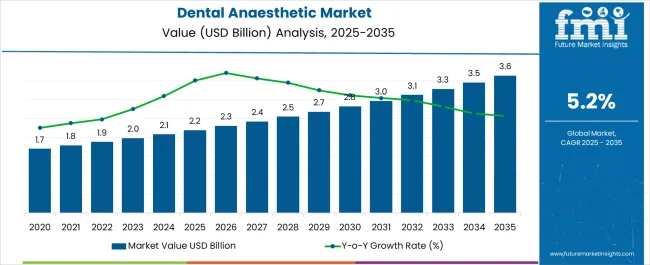
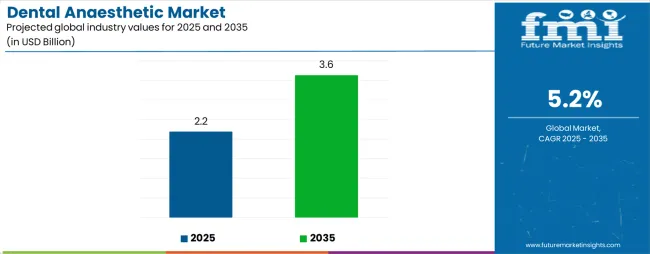
| Metric | Value |
|---|---|
| Dental Anaesthetic Market Estimated Value in (2025 E) | USD 2.2 billion |
| Dental Anaesthetic Market Forecast Value in (2035 F) | USD 3.6 billion |
| Forecast CAGR (2025 to 2035) | 5.2% |
The Dental Anaesthetic market is witnessing steady expansion, driven by the rising prevalence of dental disorders, increasing demand for cosmetic dentistry, and the growing number of dental procedures performed globally. Patients are seeking effective and painless treatments, which has encouraged dental practitioners to adopt advanced anaesthetic agents that enhance patient comfort and procedural efficiency. Continuous innovation in formulations, improvements in safety profiles, and the availability of agents with varying durations of action are shaping market dynamics.
Increasing awareness of oral healthcare, coupled with rising dental visits due to lifestyle-related oral issues and aging populations, is boosting demand. The integration of advanced diagnostic technologies and the growing preference for minimally invasive dental procedures further accelerate adoption.
Moreover, favorable government initiatives to expand access to oral healthcare, particularly in developing markets, are fostering wider utilization As dental professionals increasingly focus on patient-centric care and improved clinical outcomes, the Dental Anaesthetic market is positioned to experience long-term growth, supported by strong demand from both developed and emerging economies.
The dental anaesthetic market is segmented by product type, mode of administration, duration of action, distribution channel, and geographic regions. By product type, dental anaesthetic market is divided into Lidocaine, Mepivacaine, Prilocaine, Bupivacaine 0.5% With Epinephrine1:200,000, and Articaine.
In terms of mode of administration, dental anaesthetic market is classified into Local Infiltration, Maxillary Anaesthesia, Supraperiosteal Injection, Intraseptal Injection, Periodontal Ligament Injection, Field Block, Periapical Injection, Nerve Block, Posterior Superior Alveolar, Middle Superior Alveolar, Anterior Superior Alveolar, Mandibular Anaesthesia, Nerve Block, IAN, Akinosi, Gow-Gates, Tissue Or Skin, and Others.
Based on duration of action, dental anaesthetic market is segmented into Medium, Short, and Long. By distribution channel, dental anaesthetic market is segmented into Clinics, Hospital Clinics, Pharmacies And Drug Stores, E-Commerce, and Other. Regionally, the dental anaesthetic industry is classified into North America, Latin America, Western Europe, Eastern Europe, Balkan & Baltic Countries, Russia & Belarus, Central Asia, East Asia, South Asia & Pacific, and the Middle East & Africa.
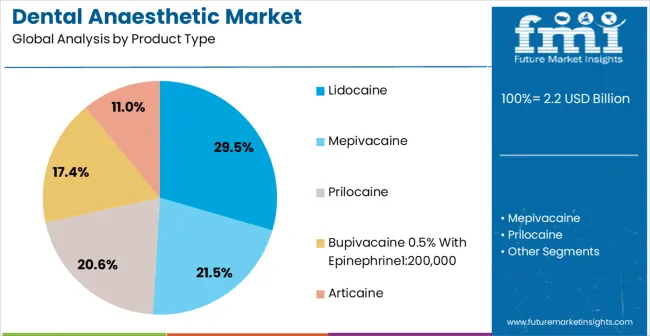
The Lidocaine product type segment is projected to account for 29.5% of the Dental Anaesthetic market’s revenue share in 2025, making it a leading choice among dental practitioners. Lidocaine’s popularity stems from its proven safety profile, rapid onset of action, and versatility across a wide range of dental procedures. It is considered the standard agent for local anaesthesia in dentistry due to its ability to provide effective pain control with minimal side effects.
Lidocaine also supports consistent results across diverse patient groups, further enhancing practitioner confidence in its use. Its extensive availability in multiple formulations and cost-effectiveness reinforce its strong market position.
Furthermore, ongoing advancements in delivery mechanisms and combination therapies are expanding the application scope of Lidocaine in dentistry As patient expectations for painless treatments continue to grow, Lidocaine’s clinical reliability and adaptability are expected to sustain its leadership in the market, supported by widespread usage across general and specialized dental practices.
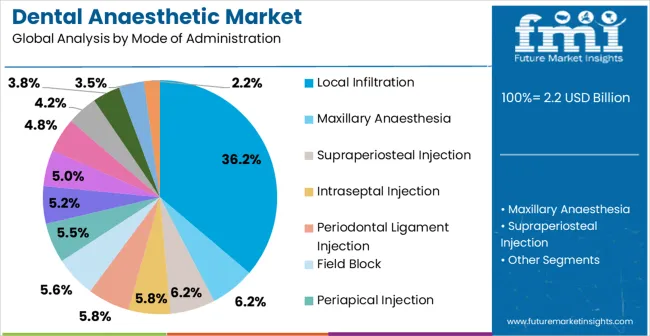
The local infiltration mode of administration is expected to hold 36.2% of the Dental Anaesthetic market’s revenue share in 2025, reinforcing its position as the most widely used technique. This dominance is attributed to its effectiveness in numbing targeted areas with minimal drug volume, ensuring both patient safety and procedural precision. Local infiltration is particularly suited for routine dental procedures such as cavity preparation, periodontal treatment, and minor surgical interventions, making it a preferred approach among dental professionals.
The technique’s ability to deliver fast-acting pain relief and reduce patient anxiety contributes to its popularity in clinical settings. Moreover, advancements in injection technologies, including computer-controlled delivery systems, have enhanced the precision and comfort associated with this method.
The cost-effectiveness and simplicity of administration further strengthen its adoption across general dental practices As the number of outpatient dental procedures continues to increase globally, local infiltration is expected to maintain its market leadership, supported by its reliability, efficiency, and widespread clinical acceptance.
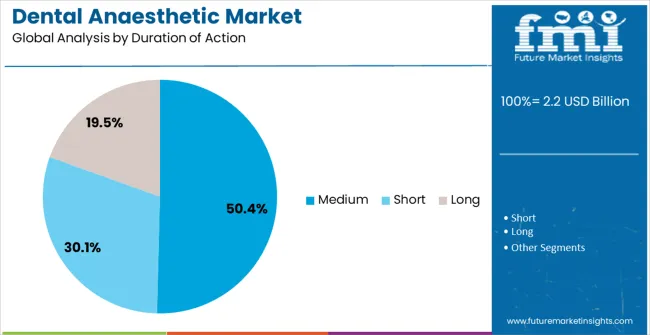
The medium duration of action segment is anticipated to capture 50.4% of the Dental Anaesthetic market’s revenue share in 2025, establishing itself as the dominant category. This segment’s prominence is being driven by its ability to provide effective pain relief for the duration of most common dental procedures without requiring repeat administration. Medium-acting agents strike a balance between efficacy and safety, offering sufficient coverage for treatments such as tooth extractions, root canal therapy, and restorative work.
Their broad applicability and consistent outcomes have positioned them as the standard choice for many dental professionals. The availability of agents with medium action duration in cost-effective formulations further supports widespread use, particularly in high-volume dental practices.
Patients also benefit from minimized discomfort post-procedure, which enhances overall satisfaction and clinical outcomes With continued innovation in anaesthetic formulations and delivery systems, the medium duration of action segment is expected to maintain its dominance, supported by strong demand across diverse dental care settings.
Dental Anaesthetic is the substance used by the dentist for partial or complete numbness of mouth. It is used to manage pain and anxiety in patients. Dental anaesthesia is a reversible process of losing sensation which is induced by the drug known as anesthetics.
This procedure is used to decrease preoperative or postoperative pain, diagnostic testing and examination and better patient’s cooperation. Dental anesthetic is injected into the gum or inner cheek. Increasing cases of gingivitis, periodontitis, cancer are expected to increase dental procedure, thus increasing the demand for dental anesthetics, globally.
Increasing use of tobacco and cigarette and changes in eating habit is expected to increase dental disorders and other disorder related to oral and maxiofacial. This increasing prevalence of dental disorders would fuel the growth for dental anesthetic market during the forecast period.
Anesthetics are very different from normal pain killers or analgesics, which relieves pain without loss of sensation. Dental anesthetic includes both general anesthetic and local anesthetic. Dental anesthetic is used in nonsurgical periodontal therapy (NSPT) procedures.
Nonsurgical periodontal therapy (NSPT) procedures are general procedures that require anesthetics in duration based on procedure. Lidocaine is the most common type of anesthesia used for anesthesia. Its half-life period in the body is 1.5 to 2 hours.
Instruments involved in local anesthesia includes anesthetic carpules, syringe, needle, mouth props and retractors. Carpules is of various size 1.7 or 1.8cc packed in blister packs and canisters. It contains preservatives for epinephrine and local anesthetic.
Syringes are two types that include: aspirating type, and non-aspirating type, Needles used in the process are available in various size, multiple gauges, and bevel, a topical anesthetic is used before local anesthetic injection to decrease the discomfort associated with anesthesia needle.
It usually contains 20% benzocaine. ADA Council on Scientific Affairs in 2003 designed color-coding system to be a part of labeling on injectable local anesthetic that carried the ADA seal of acceptance. The system was developed as a result of the growing concern of difference in color coding from manufacturer to manufacturer.
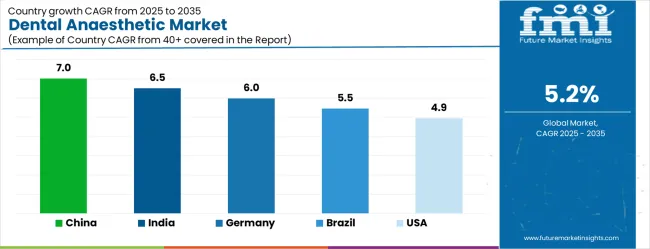
| Country | CAGR |
|---|---|
| China | 7.0% |
| India | 6.5% |
| Germany | 6.0% |
| Brazil | 5.5% |
| USA | 4.9% |
| UK | 4.4% |
| Japan | 3.9% |
The Dental Anaesthetic Market is expected to register a CAGR of 5.2% during the forecast period, exhibiting varied country level momentum. China leads with the highest CAGR of 7.0%, followed by India at 6.5%. Developed markets such as Germany, France, and the UK continue to expand steadily, while the USA is likely to grow at consistent rates.
Japan posts the lowest CAGR at 3.9%, yet still underscores a broadly positive trajectory for the global Dental Anaesthetic Market. In 2024, Germany held a dominant revenue in the Western Europe market and is expected to grow with a CAGR of 6.0%. The USA
Dental Anaesthetic Market is estimated to be valued at USD 831.1 million in 2025 and is anticipated to reach a valuation of USD 831.1 million by 2035. Sales are projected to rise at a CAGR of 0.0% over the forecast period between 2025 and 2035. While Japan and South Korea markets are estimated to be valued at USD 111.5 million and USD 69.6 million respectively in 2025.
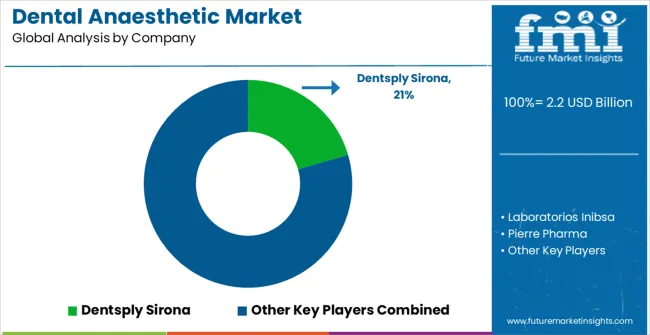
| Item | Value |
|---|---|
| Quantitative Units | USD 2.2 Billion |
| Product Type | Lidocaine, Mepivacaine, Prilocaine, Bupivacaine 0.5% With Epinephrine1:200,000, and Articaine |
| Mode of Administration | Local Infiltration, Maxillary Anaesthesia, Supraperiosteal Injection, Intraseptal Injection, Periodontal Ligament Injection, Field Block, Periapical Injection, Nerve Block, Posterior Superior Alveolar, Middle Superior Alveolar, Anterior Superior Alveolar, Mandibular Anaesthesia, Nerve Block, IAN, Akinosi, Gow-Gates, Tissue Or Skin, and Others |
| Duration of Action | Medium, Short, and Long |
| Distribution Channel | Clinics, Hospital Clinics, Pharmacies And Drug Stores, E-Commerce, and Other |
| Regions Covered | North America, Europe, Asia-Pacific, Latin America, Middle East & Africa |
| Country Covered | United States, Canada, Germany, France, United Kingdom, China, Japan, India, Brazil, South Africa |
| Key Companies Profiled | Dentsply Sirona, Laboratorios Inibsa, Pierre Pharma, Septodont, Laboratorios Normon, Primex Pharmaceuticals, Aspen Group, Dentalhitec, and Zeyco |
The global dental anaesthetic market is estimated to be valued at USD 2.2 billion in 2025.
The market size for the dental anaesthetic market is projected to reach USD 3.6 billion by 2035.
The dental anaesthetic market is expected to grow at a 5.2% CAGR between 2025 and 2035.
The key product types in dental anaesthetic market are lidocaine, _lidocaine 2% with epinephrine 1:100,000, _lidocaine 2% with epinephrine 1:50,000, _lidocaine plain, mepivacaine, _mepivacaine 2% with levonordefrin 1:20,000, _mepivacaine 3%, prilocaine, _prilocaine 4% with epinephrine 1:200,000, _prilocaine 4%, bupivacaine 0.5% with epinephrine1:200,000, articaine, _articaine 4% with epinephrine 1:100,000, _articaine 4% with epinephrine 1:200,000 and _others.
In terms of mode of administration, local infiltration segment to command 36.2% share in the dental anaesthetic market in 2025.






Our Research Products

The "Full Research Suite" delivers actionable market intel, deep dives on markets or technologies, so clients act faster, cut risk, and unlock growth.

The Leaderboard benchmarks and ranks top vendors, classifying them as Established Leaders, Leading Challengers, or Disruptors & Challengers.

Locates where complements amplify value and substitutes erode it, forecasting net impact by horizon

We deliver granular, decision-grade intel: market sizing, 5-year forecasts, pricing, adoption, usage, revenue, and operational KPIs—plus competitor tracking, regulation, and value chains—across 60 countries broadly.

Spot the shifts before they hit your P&L. We track inflection points, adoption curves, pricing moves, and ecosystem plays to show where demand is heading, why it is changing, and what to do next across high-growth markets and disruptive tech

Real-time reads of user behavior. We track shifting priorities, perceptions of today’s and next-gen services, and provider experience, then pace how fast tech moves from trial to adoption, blending buyer, consumer, and channel inputs with social signals (#WhySwitch, #UX).

Partner with our analyst team to build a custom report designed around your business priorities. From analysing market trends to assessing competitors or crafting bespoke datasets, we tailor insights to your needs.
Supplier Intelligence
Discovery & Profiling
Capacity & Footprint
Performance & Risk
Compliance & Governance
Commercial Readiness
Who Supplies Whom
Scorecards & Shortlists
Playbooks & Docs
Category Intelligence
Definition & Scope
Demand & Use Cases
Cost Drivers
Market Structure
Supply Chain Map
Trade & Policy
Operating Norms
Deliverables
Buyer Intelligence
Account Basics
Spend & Scope
Procurement Model
Vendor Requirements
Terms & Policies
Entry Strategy
Pain Points & Triggers
Outputs
Pricing Analysis
Benchmarks
Trends
Should-Cost
Indexation
Landed Cost
Commercial Terms
Deliverables
Brand Analysis
Positioning & Value Prop
Share & Presence
Customer Evidence
Go-to-Market
Digital & Reputation
Compliance & Trust
KPIs & Gaps
Outputs
Full Research Suite comprises of:
Market outlook & trends analysis
Interviews & case studies
Strategic recommendations
Vendor profiles & capabilities analysis
5-year forecasts
8 regions and 60+ country-level data splits
Market segment data splits
12 months of continuous data updates
DELIVERED AS:
PDF EXCEL ONLINE
Dental Repair Membranes for Implant Procedures Market Size and Share Forecast Outlook 2025 to 2035
Dental Cavity Filling Materials Market Size and Share Forecast Outlook 2025 to 2035
Dental Implant and Prosthetic Market Size and Share Forecast Outlook 2025 to 2035
Dental Imaging Equipment Market Forecast and Outlook 2025 to 2035
Dental Wounds Treatment Market Size and Share Forecast Outlook 2025 to 2035
Dental Radiometer Market Size and Share Forecast Outlook 2025 to 2035
Dental Diamond Bur Market Size and Share Forecast Outlook 2025 to 2035
Dental Laboratory Market Size and Share Forecast Outlook 2025 to 2035
Dental Matrix Systems Market Size and Share Forecast Outlook 2025 to 2035
Dental Permanent Cements Market Size and Share Forecast Outlook 2025 to 2035
Dental Bleaching Agent Market Size and Share Forecast Outlook 2025 to 2035
Dental Care Products Market Size and Share Forecast Outlook 2025 to 2035
Dental Etching Liquid Market Size and Share Forecast Outlook 2025 to 2035
Dental Sutures Market Analysis - Size, Share, and Forecast Outlook 2025 to 2035
Dental Hygiene Devices Market Size and Share Forecast Outlook 2025 to 2035
Dental Implantology Software Market Analysis - Size, Growth, & Forecast Outlook 2025 to 2035
Dental Veneers Market Size and Share Forecast Outlook 2025 to 2035
Dental X-Ray Systems Market Analysis - Size, Share, and Forecast Outlook 2025 to 2035
Dental Suction Systems Market Size and Share Forecast Outlook 2025 to 2035
Dental Articulators Market Size and Share Forecast Outlook 2025 to 2035

Thank you!
You will receive an email from our Business Development Manager. Please be sure to check your SPAM/JUNK folder too.
Chat With
MaRIA